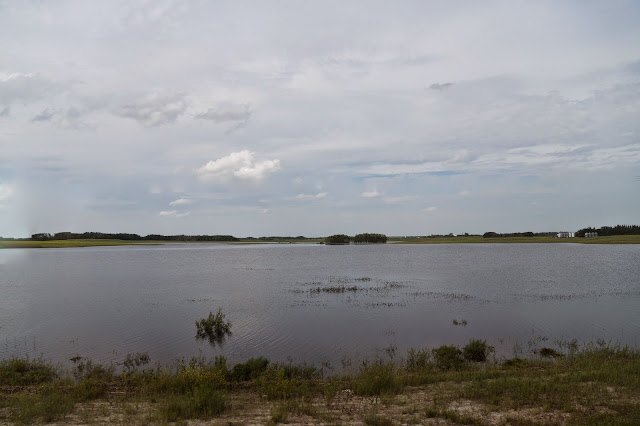When we arrived in Winnipeg we setup the RV and just made it inside when the first raindrops fell. They kept falling and blowing for nearly 2 days. Wind gusts up to 80 k per hour rocked the RV very unpredictably. Lightning and thunder were sporadic but the wind and rain were not. We were “housebound”.
That was the beginning of the dramatic flooding, particularly around Brandon. Culverts, creeks and rivers overflowed, washing away fields and roads and creating new sloughs and lakes.
Dozens of military personnel and vehicles were called in to help clean up the mess and debris.
Ducks and geese flourished in all the water.
Family discussions seem to occur everywhere.
When the rain let up we explored the Royal Canadian Mint.
Ralph is hefting half a million dollars of solid gold weighing 23 pounds – chained to the pedestal and watched carefully by Mint security.
The Winnipeg Mint produces all the coins for circulation in Canada. It has also made coins for almost half of the world’s countries. When we lived in Papua New Guinea in 1978 we were tickled to discover that the local coins were created in Canada. The Parade of Flags shows all those countries including Papua New Guinea (top of the second photo).
The wind continued on Canada Day with a lovely prairie sunset. The RV park is on the edge of the city and surrounded by farms. We drove a short distance and watched fireworks in many directions but stayed in the car to avoid the hordes of mosquitos.
The Assiniboine River joins the Red River at “The Forks” which is Winnipeg’s answer to Vancouver’s Granville Island. The shops are interesting and unique but we are not really into shopping with limited space in the RV. Ralph doesn’t believe me about shopping but I usually come out of the shops empty handed.
For over 6,000 years The Forks was a major meeting place for the First Nations people, fur traders and immigrants. Winnipeg became the “Gateway to the West” and was the starting point for Treaty No 1 and the opening of the west to homesteaders. The need for policing led to the establishment of the North West Mounted Police.
The rich, flat agricultural land is prone to flooding and changing the historic park walks.
In Steinbach we explored the Mennonite Heritage Village. My father grew up in Herbert, SK in a Mennonite family but I knew very little about his family history. At the Village I was able to connect bits of information from Dad's family and the well presented story showing the evolution of the Mennonite beliefs and customs starting from 1525.
The first families to arrive in Steinbach in 1874 had to quickly build Semlins or sod huts before winter. Being built into the ground kept the homes better insulated in the winter and summer.
When permanent homes were built barns were often attached. The homes were heated from a central brick oven with openings to each room.
We heard a lot of advertising for the re-opening of the Winnipeg Zoo with a new exhibit “Journey to Churchill”. Our visit was well worth the early start to avoid the crowds.
The polar bear compound looks like a realistic summer in the Arctic.
People can walk through a tunnel under the bear’s water world. We waited a few times but never saw the bears over our heads.
The bears are being trained to respond to human signals as part of their stimulation and exercise.
The display of different inuksuits showed how the cairns were used in the North.
This peacock certainly fit the saying “as proud as a peacock”.































No comments:
Post a Comment